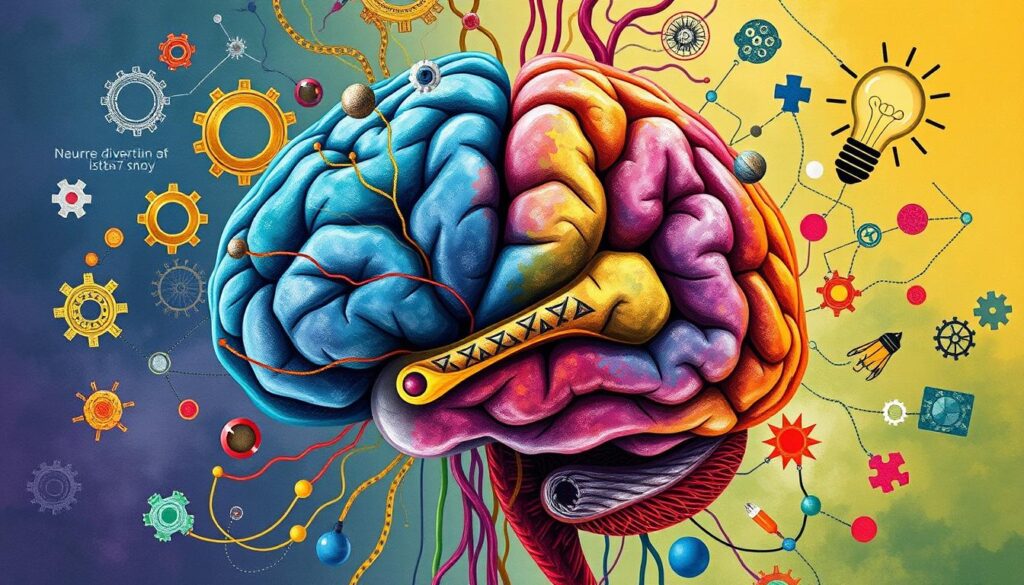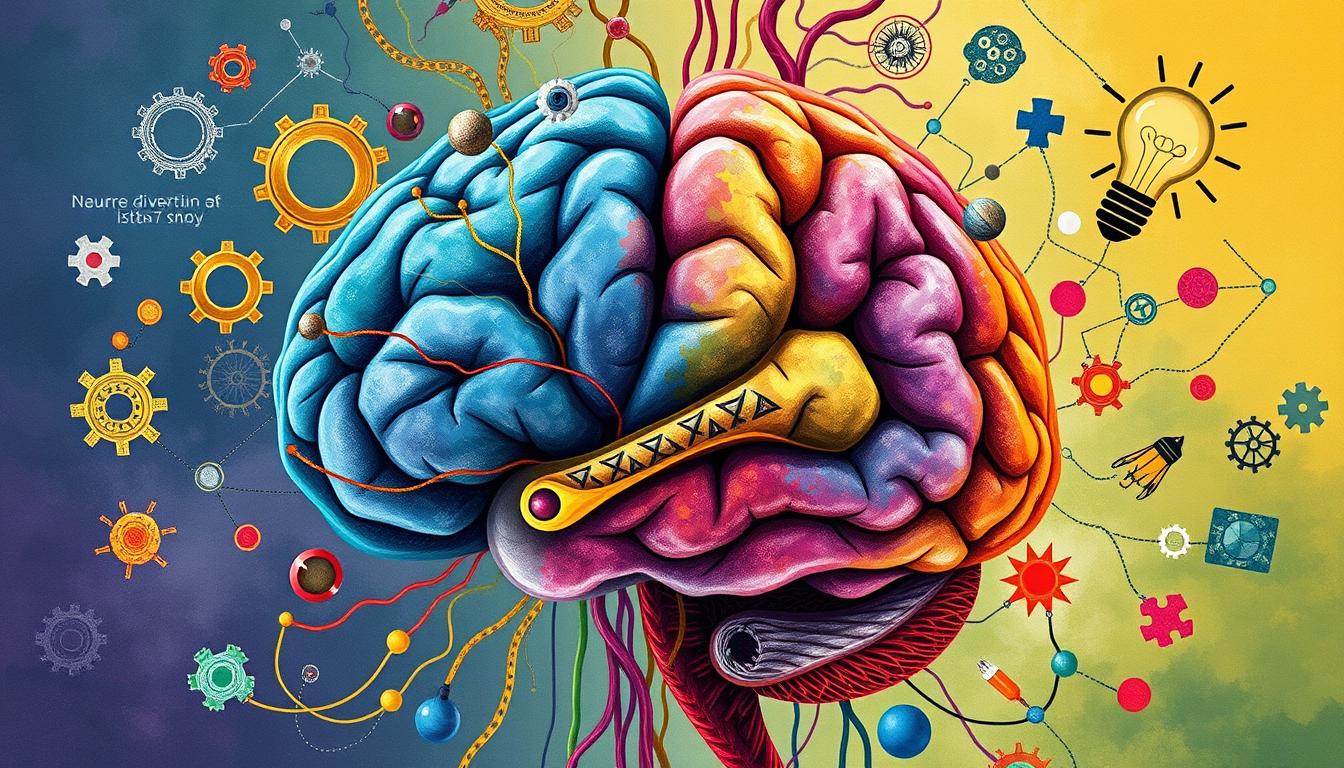In our world, celebrating conformity has changed with the rise of neurodiversity. People with neurodivergent brains, whose thinking is different from the norm, are now proud of their unique ways. The neurodivergent test is a key tool for them to learn more about themselves.
When you take a neurodivergent test, you get to see how your brain works. You learn how it handles information, solves problems, and interacts with others. This knowledge can change your life, helping you use your strengths, tackle challenges, and follow your natural path.
Key Takeaways
- Neurodivergent testing helps individuals understand their unique brain style and cognitive patterns.
- Embracing neurodiversity is a growing movement that celebrates the diversity of human minds.
- Exploring one’s neurodivergent traits can lead to greater self-awareness and personal empowerment.
- Neurodivergent tests can provide valuable insights for personal growth and professional development.
- Understanding one’s neurodivergent traits can foster greater acceptance and support in various areas of life.
Understanding Neurodiversity and Brain Differences
The idea of neurodiversity has become more popular lately. It challenges the idea of a single “normal” brain. Neurodiversity says that the neurodivergent brain is just a natural variation in how we think, not a problem.
This change has helped us see neuro diversity in a new light. It’s helped us become a more welcoming society for everyone.
The Evolution of Neurodiversity Acceptance
The movement for neurodiversity started in the 1990s with the disability rights movement. People with autism were at the forefront, pushing for acceptance. Now, it includes many other neurological differences like ADHD, dyslexia, and Tourette’s syndrome.
As more people learn about it, acceptance has grown. Now, neurodivergent individuals are seen as important members of our communities.
Breaking Down Common Misconceptions
Even with progress, many still misunderstand neurodiversity. Some think neurodivergent people are less capable or “abnormal.” Others see it as a personal flaw or something to be “fixed.”
But the truth is, neurodivergent brains often bring unique strengths and views. These can be incredibly valuable in our diverse world.
“Neurodiversity is the idea that variations in the human brain are normal and that neurological differences like autism, ADHD, and dyslexia should be recognized and respected as any other human variation.”
By fighting these myths and celebrating neuro diversity, we can make a better place for everyone. A place where everyone’s differences are valued and respected.
What Does Being Neurodivergent Really Mean?
The term “neurodivergent” describes people whose brains work differently from the usual. Neurodivergence covers a wide range of brain differences, each with its own strengths and challenges. It’s important to understand neurodivergence to build a more inclusive and caring society.
Neurodivergence is about the natural variety in how our brains work. It shows that there’s no one “right” way to think or process information. People with neurodivergence might notice things more, solve problems in new ways, or have a bigger imagination. These differences are not weaknesses, but signs of the amazing diversity of human brains.
There are many types of neurodivergence, like ADHD, Autism, Dyslexia, and Tourette’s Syndrome. Each one brings its own set of abilities and challenges, challenging the idea of a single “normal” brain.
“Neurodivergence is not a disorder, but rather a natural variation in the human condition. Embracing these differences is key to creating a more inclusive and understanding world.”
By accepting and celebrating neurodivergence, we can create a place where everyone’s unique contributions are valued. This change helps neurodivergent people use their strengths and get the support they need in a world made for neurotypical brains.
Being neurodivergent means celebrating the diversity of human thinking and how our brains work. It’s a way to honor the richness and complexity that makes each of us special.
Common Types of Neurodivergent Conditions
Neurodiversity includes many neurodivergent examples and neurodivergent disorders. ADHD and autism spectrum disorders are well-known. But, there are many other cognitive and neurological differences too.
ADHD and Autism Spectrum
ADHD and Autism Spectrum Disorder are common adhd neurodivergent conditions. ADHD causes inattention, hyperactivity, and impulsivity. Autism spectrum disorders affect social communication, sensory processing, and thinking patterns.

Dyslexia and Learning Differences
Dyslexia affects reading and writing skills. It’s a neurodivergent example. People with dyslexia struggle with phonological awareness and language processing. Dyscalculia, dysgraphia, and other learning differences are also neurodivergent.
Other Neurodivergent Patterns
There are many neurodivergent disorders beyond ADHD, autism, and learning differences. Tourette’s syndrome, Obsessive-Compulsive Disorder (OCD), and Sensory Processing Disorder (SPD) are examples. Each has unique cognitive and neurological features.
| Condition | Key Characteristics | Common Challenges |
|---|---|---|
| ADHD | Inattention, hyperactivity, impulsivity | Staying focused, regulating emotions, time management |
| Autism Spectrum Disorder (ASD) | Difficulty with social communication, sensory processing, rigid thinking | Navigating social situations, sensory overload, inflexibility |
| Dyslexia | Challenges with reading, writing, and language-based processing | Phonological awareness, rapid automatic naming, spelling |
| Tourette’s Syndrome | Involuntary physical and vocal tics | Suppressing tics, social stigma, co-occurring conditions |
It’s important to recognize the wide range of neurodivergent examples and neurodivergent disorders. This helps us celebrate the unique strengths and perspectives of each individual.
Signs and Characteristics of Neurodivergent Thinking
Exploring the neurodivergent brain is a journey of self-discovery. Each person’s experience with neurodiversity is different. Yet, there are common signs and traits that show a neurodivergent way of thinking. Understanding these can help people see their strengths and challenges more clearly.
One key trait of the neurodivergent mind is its creativity and innovative thinking. People with neurodiversity often think differently, finding new solutions to problems. This way of thinking is valuable in many areas, from art to technology.
Another important feature is intense focus and attention to detail. Neurodivergent individuals can dive deep into their interests, showing great focus and an eye for detail. This skill is useful in tasks that need careful attention, like data analysis or art.
Common Characteristics of Neurodivergent Thinking
- Exceptional creativity and innovative problem-solving
- Intense focus and attention to detail
- Heightened sensory awareness and sensitivity
- Unique communication styles and social interactions
- Nonlinear thinking patterns and unconventional approaches
- Diverse learning styles and preferences
The neurodivergent experience is unique for everyone. It’s shaped by genetics, environment, and personal experiences. By celebrating the strengths and views of the neurodivergent mind, we can make the world more inclusive and rich for all.
| Characteristic | Description |
|---|---|
| Heightened Creativity | Neurodivergent individuals often show great creative skills and solve problems in new ways, bringing a unique perspective to tasks. |
| Intense Focus | They can focus deeply on their interests, showing great attention to detail and becoming fully immersed in their passions. |
| Sensory Sensitivity | Some may feel sensory experiences more intensely, leading to a deeper appreciation for them or sensitivity to the environment. |
| Diverse Communication | Neurodivergent individuals have unique ways of communicating and interacting, which might be misunderstood by those who don’t know about neurodiversity. |
“The neurodivergent mind is a tapestry of unique perspectives, woven together to create a richly diverse human experience.”
Taking Your First Neurodivergent Test
Exploring your brain’s unique wiring can be a life-changing journey. You might be wondering if you’re neurodivergent or just want to know more about your brain. Taking a neurodivergent test can give you valuable insights. Let’s explore how to find the right test and understand your results.
Professional vs. Online Assessments
You have two main options for testing your neurodivergence: professional assessments and online tests. Professional tests, done by licensed experts, are detailed and validated. They include interviews, cognitive tests, and a look at your past. These tests are more thorough but cost more.
Online tests are cheaper and easier to access. They can help you spot potential neurodivergence. But, they might not be as detailed or accurate as professional tests.
Preparing for Your Assessment
- Gather info about your past, like any diagnoses or learning issues.
- Make a list of your strengths, weaknesses, and coping strategies.
- Think about life events that might have shaped your thinking.
- Consider getting a trusted friend or family member to share insights.
Understanding Test Results
Test results, whether from a professional or online test, offer valuable insights. They might give you a specific diagnosis or show how your brain works differently. It’s key to be open and curious about your results. They can help you understand yourself better and celebrate your neurodivergence.
“The greatest gift we can give ourselves is the courage to see our differences as strengths, not weaknesses.” – Anita Lesko, Autism Advocate
TO WATCH THE VIDEO CLICK HERE
Remember, a neurodivergent test is not about labeling you. It’s about empowering you to understand and celebrate your brain’s uniqueness. Embrace this journey of self-discovery. Let the insights guide you towards a more fulfilling life.
Benefits of Understanding Your Brain Style
Learning about your neurodivergent brain can bring many benefits. It helps you understand how you think and work. This knowledge lets you be more aware of yourself and find ways to handle challenges.
Knowing your neurodivergent meaning makes life easier. You’ll see your different ways of thinking as strengths, not weaknesses. This boosts your confidence and helps you make better choices.
Also, understanding your neurodivergent brain helps you grow personally and professionally. You can learn how you best learn and communicate. This way, you can work more efficiently and achieve your goals.
| Benefit | Description |
|---|---|
| Improved self-awareness | Gain a deeper understanding of your cognitive patterns and strengths, leading to better self-acceptance and resilience. |
| Tailored coping strategies | Develop personalized techniques to navigate life’s challenges and thrive in various settings. |
| Unlocked potential | Leverage your distinctive thinking style to excel in your personal and professional pursuits. |
Embracing your neurodivergent side can change your life for the better. By celebrating your unique brain, you can reach your full potential. This makes a big difference in the world.
“The greatest gift we can give to the world is the full expression of our authentic selves.” – Heather Britt
Supporting Neurodivergent Individuals in Daily Life
Understanding the unique needs of neurodivergent individuals is key. This includes the workplace, education, and personal relationships. Creating a supportive environment can greatly improve their lives.
Workplace Accommodations
Neurodivergent people often have special skills and views. Employers can help them succeed with the right accommodations. This might include noise-cancelling headphones, flexible hours, or quiet work areas.
Educational Support Strategies
Neurodivergent students face big challenges in school. But, with the right support, they can do well. Using methods like multisensory teaching and assistive tech can help a lot.
Building Supportive Relationships
It’s important to build understanding in personal relationships. Learning about neurodiversity helps create strong bonds. Listening and communicating openly are key to supporting unique needs.
By embracing brain diversity and supporting neurodivergent individuals, we can build a more inclusive world. Everyone deserves to thrive.
“Neurodiversity is the idea that there is a natural and valuable range of differences in human cognition and behavior.”
Living Successfully with Neurodivergence
Embracing your neurodivergent nature is a journey of empowerment and growth. People with neurodivergent traits have unique strengths. These can lead to amazing achievements and happiness.
Alex, a successful entrepreneur, was diagnosed with ADHD as an adult. Their ability to focus deeply and think creatively helped their startup succeed. This success shows how understanding your neurodivergent mind can lead to success.
Maya, an artist with dyslexia, uses their visual skills to create stunning art. Their unique paintings have won praise, showing how embracing neurodivergent traits can lead to great achievements.
“The greatest strength of a neurodivergent individual lies in their ability to perceive the world differently, to think outside the box, and to bring fresh perspectives to the table.”
In many fields, neurodivergent examples show the value they bring. By being aware of themselves and using support, neurodivergent people can excel. They show us the beauty of diversity.
The journey of living with neurodivergence may not always be easy. But it’s a path worth taking. By embracing their differences, neurodivergent individuals can reach their full potential. They inspire us to celebrate diversity.
Conclusion
We’ve learned a lot about neurodiversity, showing how diverse our brains are. We’ve seen how acceptance has grown over time. And we’ve cleared up some common myths.
This journey has taught us to value our unique ways of thinking. The neurodivergent test helps us find out more about our brains. It’s a step towards understanding ourselves better.
Whether you have ADHD, autism spectrum, or dyslexia, knowing your neurodivergent traits is key. It opens doors to new possibilities.
Let’s celebrate the variety in our minds and the gifts neurodivergent people bring to our world. By accepting and supporting each other, we help everyone reach their best. Our journey of self-discovery is ongoing, leading to more inclusive and understanding places.
FAQ
What is a neurodivergent test?
A neurodivergent test helps people understand their brain’s unique patterns. It shows if someone has traits like ADHD, autism, or dyslexia. This can give insight into their neurodivergent traits.
What does it mean to be neurodivergent?
Being neurodivergent means your brain works differently than most. People with neurodivergent brains think, learn, and behave in unique ways. These differences can be seen in how they interact with the world.
What are the common types of neurodivergent conditions?
Common neurodivergent conditions include ADHD, autism, and dyslexia. There’s also Tourette’s syndrome and OCD. These conditions often bring special talents and ways of seeing the world.
How can I identify signs of neurodivergence in myself or others?
Signs of neurodivergence include being very detail-focused and creative. You might notice intense interests or sensitivity to sounds and lights. It’s also about how someone interacts with others and thinks differently.
How do I take a neurodivergent test?
You can get a neurodivergent test from a mental health expert or online. But, online tests should come from trusted sources. Always remember, self-assessments have their limits.
What are the benefits of understanding my brain style?
Knowing your brain style can improve your self-awareness and coping skills. It helps you advocate for yourself and appreciate your strengths. This can lead to making a positive impact in society.
How can I support a neurodivergent individual in their daily life?
Supporting someone neurodivergent means making their environment inclusive. This includes workplace adjustments and educational strategies that fit their needs. Building empathy and understanding is key to creating a supportive space.
TO EXPLORE MORE TOPICS CLICK HERE



